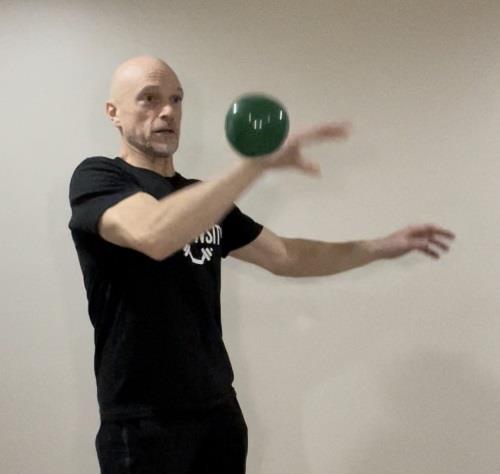This is part 2 of a two-part article. Part 1 addresses the myth of superfoods and part 2 presents ideas for superfitness: how to enhance the brain health benefits of exercise by manipulating intensity and complexity.
Time for a practical example of how to supercharge exercise to maximize the brain health benefits. In general, we want just enough physical intensity to provide a physical challenge and just enough cognitive complexity to provide a coordination or motor challenge.
Here are 4 possible combinations of intensity and complexity. Any of these can be appropriate for a certain type of person.
| Physical Intensity | Cognitive Complexity | |
| Low-Low | Low | Low |
| Low-High | Low | High |
| High-Low | High | Low |
| High-High | High | High |
To illustrate this concept, I will use a Squat with a Ball. The video will show a progression through higher levels of cognitive and coordination challenge. (Meaning, the Low-Low up to Low-High in the table above.) It does not show progressive physical intensity (apart from the small increase in physical intensity from the progressive action placed on the ball.) Progressing physical intensity is easy to figure out as it is what the fitness industry already does ad nauseum, and an example is offered verbally in the video by suggesting that the entire sequence of exercises below could be done using a squat jump.
- Squat with Ball Pass (from one hand to the other)
- Squat with Ball Toss (higher toss, higher challenge)
- Squat with Ball Same Arm Toss
- Squat with Ball & Ball “Orbit”
- Squat with Ball “Orbit” alternating clockwise and counterclockwise directions
Note that lighter objects like a tennis ball are more familiar but are potentially somewhat harder to control. Heavier balls like the 4.4 pound (2 kilogram) ball used in the video move more predictably due to the higher inertia. Further, additional cognitive complexity could be introduced by using an oddly shaped object like a stick, pillow, or stuffed animal…this concept does not require any special equipment although it works equally well with stuff you have around the house as it does with fitness equipment.
Lastly…Why Bother?
It is the intensity of physical training that enhances neuroplasticity and improves cognition. With coordination and motor skills, it is the complexity that increases neuroplasticity and improves cognition. Doing both simultaneously – combining cognitive and motor demands with physical activity – has proven more effective in improving cognitive functioning than either alone. (Netz, 2019)
References
Netz, Y. (2019). Is There a Preferred Mode of Exercise for Cognition Enhancement in Older Age?—A Narrative Review. Frontiers in Medicine, 6. https://doi.org/10.3389/fmed.2019.00057

